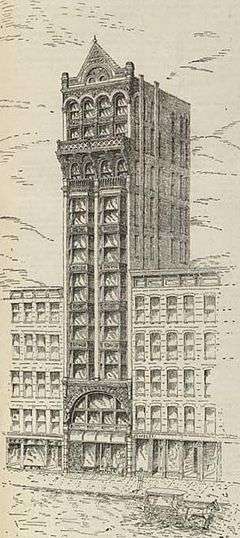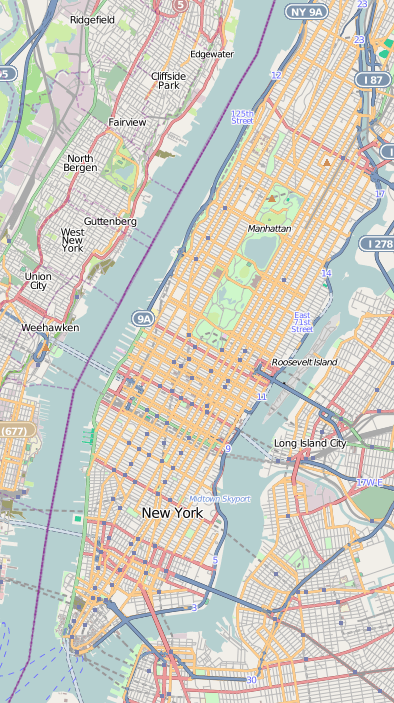14 Maiden Lane
14 Maiden Lane, or the Diamond Exchange, is an early example of a New York skyscraper in what is now the Financial District of Manhattan. Completed in 1894, it is still standing.
| Diamond Exchange | |
|---|---|
 1894 rendering from Real Estate Record and Builders' Guide | |
 14 Maiden Lane Location in Manhattan | |
| General information | |
| Type | Residential (formerly offices) |
| Address | 14 Maiden Lane |
| Town or city | New York |
| Country | United States |
| Coordinates | 40°42′33″N 74°00′34″W |
| Construction started | 1893 |
| Construction stopped | 1894 |
| Cost | $275,000 |
| Height | 120 feet (37 m) |
| Technical details | |
| Structural system | Wall-braced cage |
| Material | Steel, iron and brick |
| Floor count | 10 |
| Lifts/elevators | 1 |
| Design and construction | |
| Architect | Gilbert A. Schellenger |
| Developer | Boehm & Coon |
| References | |
| [1] | |
History
At the end of the 19th and beginning of the 20th centuries, the area around Maiden Lane and John Street became home to a number of early skyscrapers built speculatively to house businesses attracted to the booming financial district, which was expanding north.[2] Maiden Lane was already established as the center of the city's jewelry district as early as 1795, and the area near Broadway was a busy shopping district.[3] In 1892, Manhattan real-estate developers Abraham Boehm and Lewis Coon announced that they had acquired the property at 14 Maiden Lane and intended to demolish the existing structure, replacing it with a ten-story tower specifically intended for the diamond trade.[4] At the time, the planned building would be among the tallest in the city, as elevators and new building techniques permitted ever higher construction and the city's rapid growth created an insatiable real-estate market.[1]
Design and construction
Boehm and Coon hired prolific New York City architect Gilbert A. Schellenger to design the building for the specific requirements of diamond merchants and jewelers.[2][5] The building was of fireproof construction, with a cast-iron and steel frame, and hollow-brick floor arches.[5] The frame and floors were made unusually strong in order to accommodate the heavy safes required by the trade, large windows provided ample daylight, augmented by gas and electric lights, and the facade was ornately decorated.[5] Constrained by the narrow 23.5 feet (7.2 m) lot, Schellenger emphasized the building's slenderness with three slim brick colonnettes flanking the large bay windows on the building's face.[1][6] The tall, narrow building towered over the older, neighboring structures.[5]
Cast-iron and steel construction were both relatively new techniques, and construction of the Diamond Exchange suffered a major setback in October 1893 when a powerful windstorm caused the incomplete cage to shift about 10 inches (250 mm) from plumb.[7][8] The problem was eventually traced back to oversized holes in splices on the cast-iron columns. Each new story added to the cage permitted additional movement, and the force of the wind was sufficient to cause the whole structure to tilt.[8][9] To resolve the problem, the builders were forced to install "knee braces" at the ceiling line of each story, converting the original unbraced cage to a braced design.[7][8] In 1904 the same flaw led to the collapse of the eleven-story Darlington Hotel, also in New York, which killed 25 construction workers.[8]
Construction was completed in 1894 and the building was occupied by jewelers and diamond dealers. The ground floor, decorated in polished granite, was leased to retail tenants;[5] in 1915 it became home to Tessaro's, a dealer in rare books.[10] One year after it was completed, the developers sold the building for $375,000 (it had cost approximately $275,000 to build).[11]
While many early skyscrapers have been demolished or dwarfed by modern neighbors, the Diamond Exchange, as of 2016, still stands above the adjacent buildings. In 1920, the buildings to the east were destroyed in a fire which killed several people.[12] The buildings to the west were demolished in 2015 to make way for a planned hotel.[13]
References
- "Ten and Taller". The Skyscraper Museum. 2016. Retrieved 23 October 2016.
- Federal Transit Administration (2004). Fulton Street Transit Center, New York, New York, Section 4(f) Evaluation: Environmental Impact Statement. pp. 255–256.
- Zapata, Janet (2010). "Jewelry". In Kenneth T. Jackson; Lisa Keller; Nancy Flood (eds.). The Encyclopedia of New York City (2 ed.). Yale University Press. pp. 3159–3161. ISBN 9780300182576. Retrieved 24 October 2016.
- "To Build a Diamond Exchange" (PDF). The World. 17 November 1892. p. 1. Retrieved 24 October 2016.
- "The Diamond Exchange Building No. 14 Maiden Lane". Real Estate Record and Builders' Guide. 53 (1366): 801. 19 May 1894.
- "John Street/Maiden Lane: A Brief History" (PDF). District Lines. 18 (2): 10. Autumn 2004.
- "Amending the Findings of a Board of Survey on an Unsafe Building Case". Real Estate Record and Builders' Guide. 54 (1374): 5–6. 7 July 1894. Archived from the original on 2016-11-03. Retrieved 2016-10-25.
- Friedman, Donald (2010). Historical Building Construction: Design, Materials, and Technology. W.W. Norton and Company. pp. 61–65. ISBN 9780393732689.
- "Suit over a Maiden Lane Building". New York Times. 10 July 1895. p. 3. Retrieved 24 October 2016.
- "Leases". Real Estate Record and Builders' Guide. 96 (2484): 696. 23 October 1915. Archived from the original on 2016-10-27. Retrieved 2016-10-25.
- "Gossip of the Week". Real Estate Record and Builders' Guide. 56 (1426): 40. 13 July 1895. Archived from the original on 2016-10-27. Retrieved 2016-10-25.
- "Fatal Fire in Maiden Lane". The Jewelers' Circular. 79 (2): 128. 21 January 1920.
- "FiDi residents fight W&L's light-up hotel idea". The Real Deal. 3 April 2015. Retrieved 24 October 2016.